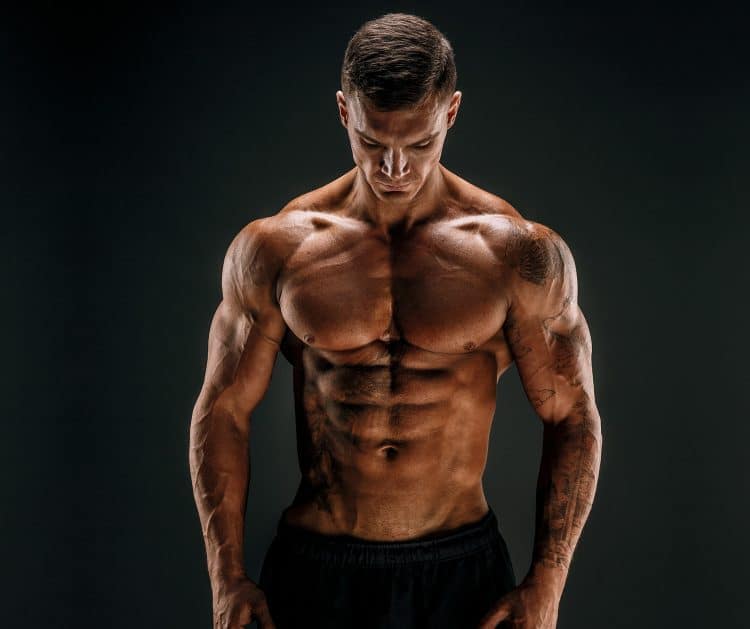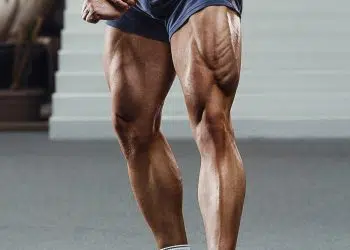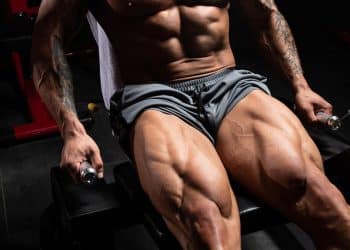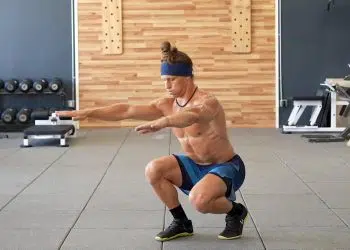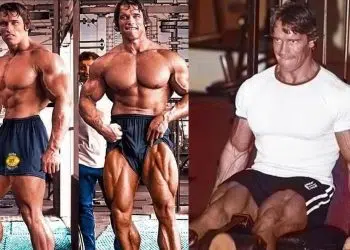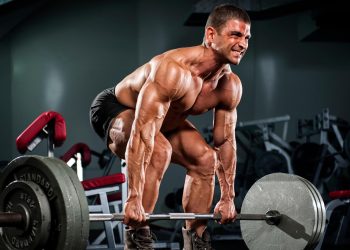It’s unclear who invented 21s, also known as the Matrix training system. Some attribute 21s to Dr. Ronald Laura, while others credit old-school English bodybuilder Wag Bennett, an early mentor of Arnold Schwarzenegger. Bennet may have learned about 21s from The Iron Guru, Vince Gironda. Schwarzenegger went on to write about 21s in his bestselling book, The New Encyclopedia of Modern Bodybuilding.
Regardless of who invented 21s, it was it’s clear that they discovered a powerful workout method. 21s have been popular for over half a century, which strongly suggests that they work.
In this article, we explain why and how to do 21s, and how to use this training method with other exercises.
What Are 21s Anyway?
21s involve breaking your rep down into three ranges of motion. You do seven reps in each phase, totaling 21, which is where this training method gets its name.
The three ranges of motion are:
- Outer range – 7 reps
- Inner range – 7 reps
- Full range – 7 reps
21s are most commonly associated with biceps curls. In fact, that’s probably the only exercise that many people use 21s for. Just in case you’ve been living in a cave and have never seen or heard of 21s, this is how you do biceps 21s:
Level Up Your Fitness: Join our 💪 strong community in Fitness Volt Newsletter. Get daily inspiration, expert-backed workouts, nutrition tips, the latest in strength sports, and the support you need to reach your goals. Subscribe for free!
- Hold a barbell or an EZ bar with an underhand, shoulder-width grip. You can also use a cable machine or dumbbells.
- Stand with your feet shoulder-width apart, shoulders down and back, core braced, and arms straight.
- Bend your elbows and curl the bar up until your forearms are parallel to the floor. Extend your arms and repeat for seven reps.
- Next, curl the bar up from halfway to the top. Lower the bar until your forearms are parallel to the floor and repeat for seven reps.
- Finally, do seven full-range reps, from full arm extension to full flexion.
While biceps 21s are a great way to build bigger arms, you can use this training method with many other exercises. It’s just a matter of letting your imagination run wild and applying 21s to the other exercises in your workouts.
What Makes 21s so Effective?
There are several reasons that 21s can help build muscle.
Firstly, 21s work because of something called occlusion. Occlusion occurs when a muscle is contracted, and blood cannot flow into or out of whatever body part you are training. This creates hypoxia within the muscle, which is the technical term for oxygen starvation.
Lack of blood flow to a muscle tricks your body into thinking it is working harder than it really is. Lactic acid levels rise, which produces a cascade of anabolic substances, including growth hormone, insulin growth factor, mTOR, and myostatin, all of which are critical for muscle growth.
Then, as blood flow is restored, there is a massive influx of blood back into the target muscle, which produces a terrific pump. The pump is, as every bodybuilder knows, another mechanism of muscle growth.
All of this means that 21s work a lot like blood flow restriction training, or BFR for short. However, instead of using an external compression cuff to reduce blood flow, 21s keep your muscles under constant tension to produce the same effect.
21s also keep your muscles under tension for longer. Doing 21s means you don’t get to relax between reps, and that additional tension causes more microtrauma, which is another trigger for hypertrophy.
The last reason that 21s work so well is the so-called novelty effect. Adding 21s to your workout introduces a new type of stress, which literally shocks your muscles into renewed growth. That’s why new training methods and exercises often result in an increase in post-exercise muscle soreness; your muscles just aren’t used to them.
Getting More From 21s
Get the best possible results from 21s with the following hints and tips:
Level Up Your Fitness: Join our 💪 strong community in Fitness Volt Newsletter. Get daily inspiration, expert-backed workouts, nutrition tips, the latest in strength sports, and the support you need to reach your goals. Subscribe for free!
- Avoid momentum – raise and lower the weights with control to keep maximum tension on the target muscles. The range of motion in the first two phases is small and swinging the weights up could mean you end up with very little stress on the target muscles.
- Use light to moderate weights – leading on from above, if you go too heavy, you’ll probably end using momentum to lift the weights up. Avoids this by using light to moderate weights so you can focus on squeezing your muscles rather than jerking the weight up.
- Don’t rush the last seven reps – watch a lot of people do 21s, and you’ll see them rushing to finish the last seven reps. This is probably due to the intense burning they can feel! Lift and lower the weight slowly to maximize muscle tension and metabolic stress. Speeding up makes this system less effective. Use less weight if you feel you cannot complete the last seven reps in good form.
- Try other reps ranges – while 21s are done using seven reps per range of motion, there is nothing to stop you from doing less or more reps, depending on your strength and how much weight you are using. For example, you could do five reps in each phase of the exercise or ten. Experiment to see what works best for you.
Using 21s with Other Exercises
While biceps 21s are the most common way to do 21s, there is nothing to stop you from using it with other exercises. All you need to do is divide your reps down into the three phases (inner range, outer range, full range) and get to work.
Exercises that work particularly well with 21s include:
1. Leg Extension 21s
Want to hammer your quads and get a wicked thigh pump? Give leg extension 21s a try. And yes, that deep burning you can feel is entirely normal!
How to do it:
- Sit on the leg extension with your knees in line with the machine’s pivot point. Then, adjust the leg pad, so it’s just above your ankles.
- Extend your legs and lift the weight halfway up. Bend your knees and lower the weight back down, stopping just short of letting the plates touch together. Do seven reps.
- Next, do seven reps from halfway up to full knee extension.
- Finally, do seven full-range reps.
2. Dumbbell Bench Press 21s
21s are usually done with isolation or single-joint exercises, but that doesn’t mean you can’t use them for compound or multi-joint exercises. Dumbbell bench press 21s will give your pecs a great workout. Don’t go too heavy too soon; this exercise is more strenuous than it looks!
How to do it:
- Lie on your bench with a dumbbell in each hand. Lower the dumbbells down to your shoulders. This is your starting position.
- Press the dumbbells halfway up and then lower them back to your shoulders. Do seven reps.
- Next, press the dumbbells from halfway up to full arm extension. Lower them back to halfway and repeat seven times.
- Finish off your set with seven full reps.
- You can also do this exercise with a barbell.
3. Dumbbell Shoulder Press 21s
This 21s exercise is a little different because as well as changing the range of motion, the movement changes too. This provides a uniquely painful and effective deltoid workout. Again, go light because this exercise is much harder than it looks!
How to do it:
- Sit on an exercise bench and hold a dumbbell in each hand. Raise the weights to shoulder level, elbows held out to the side. Brace your core and pull your shoulders down and back.
- Press the dumbbells halfway up and then lower them back to your shoulders for seven reps.
- Next, bring your elbows forward and together for seven reps. Keep your upper arms parallel to the floor.
- Lastly, do seven full-range reps.
4. Lateral Raise 21s
This exercise works well with dumbbells, cables, or resistance bands. However you do it, lateral raise 21s will set your medial deltoids on fire!
How to do it:
- Hold a dumbbell/handle in each hand, arms by your sides. Raise your arms halfway up and then lower them again. Repeat seven times.
- Next, raise your arms from halfway up to parallel to the floor. Lower them and repeat seven times.
- Finally, do seven full-range reps.
5. Calf Raise 21s
If you are struggling to build your calves, this exercise could be just what you’ve been looking for. It keeps your calves under near-constant tension, creates a deep pump and burn, and should literally shock them into growing.
How to do it:
- Stand with the balls of your feet on the edge of the calf raise machine step. Raise up onto your tip toes. This is your starting position.
- Lower your heels down until they are roughly level with your toes. Push back up and repeat seven times.
- Next, lower your heels all the way down to get a deep stretch in your calves. Raise your heels up until they’re level with your toes and repeat seven times.
- Finally, do seven full-range reps.
- You can also do this exercise in reverse, i.e., starting in the bottom stretched position.
Your use of 21s is limited only by your creativity and imagination. Other exercises worth trying include:
Elevator Reps – The New 21s!
As good as 21s undeniably are, like any training method, they’ll start to lose their potency if you do them too often. The good news is that there is an alternative way to do 21s that you can use to keep your workouts fresh and productive – elevator reps.
Elevator reps and 21s are similar and work in much the same way. However, instead of doing seven reps of each range of motion in sequence, you do one rep of each range and repeat for as many cycles as required.
Confused? Don’t be – here’s an explanation and video demonstration of how to do elevator rep pull-ups:
- Hang from a pull-up bar with an overhand, underhand, or neutral grip as preferred.
- Bend your arms and pull yourself halfway up.
- Extend your arms and then pull yourself three-quarters of the way up.
- Extend your arms and then do one complete rep.
- That’s one elevator rep – keep going.
Like 21s, you can use elevator reps with a wide range of exercises. This method works best with light to moderate weights and medium to high reps. Chase that pump!
Learn more about 21s:
- How To Build Bigger Arms With Biceps 21s
- Dexter Jackson Shares Favorite Biceps 21s Session
- 30-Minute Leg Workout
21s: Not Just for Biceps – Wrapping Up
Variety, they say, is the spice of life, and that’s especially true in strength training. Even the best exercise and workout can lose its potency if you do it too often. Stick with the same workout long enough, and you’ll eventually find yourself stuck in a training rut.
Avoid progress plateaus by changing your workouts every couple of months and making micro-changes from one week to the next. For example, add some drop sets, do a few forced reps, change your training tempo, or switch to 21s or elevator reps.
Or, if you don’t want to build more muscle, stick with the same tired old workout and don’t change your exercises – it’s up to you!

